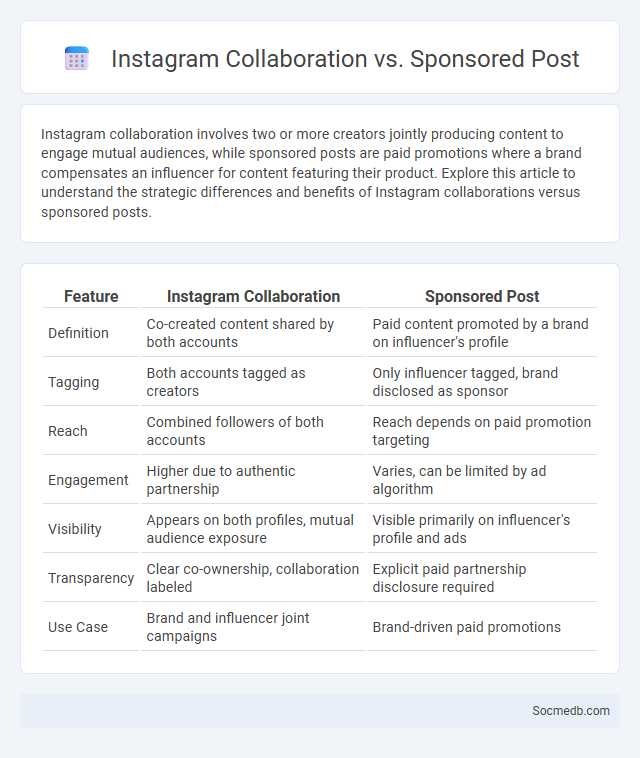
Photo illustration: Instagram Collaboration vs Sponsored Post
Instagram collaboration involves two or more creators jointly producing content to engage mutual audiences, while sponsored posts are paid promotions where a brand compensates an influencer for content featuring their product. Explore this article to understand the strategic differences and benefits of Instagram collaborations versus sponsored posts.
Table of Comparison
| Feature | Instagram Collaboration | Sponsored Post |
|---|---|---|
| Definition | Co-created content shared by both accounts | Paid content promoted by a brand on influencer's profile |
| Tagging | Both accounts tagged as creators | Only influencer tagged, brand disclosed as sponsor |
| Reach | Combined followers of both accounts | Reach depends on paid promotion targeting |
| Engagement | Higher due to authentic partnership | Varies, can be limited by ad algorithm |
| Visibility | Appears on both profiles, mutual audience exposure | Visible primarily on influencer's profile and ads |
| Transparency | Clear co-ownership, collaboration labeled | Explicit paid partnership disclosure required |
| Use Case | Brand and influencer joint campaigns | Brand-driven paid promotions |
Introduction to Instagram Collaborations, Sponsored Posts, and Sponsored Content
Instagram collaborations allow you to partner with influencers or brands to create authentic content that reaches a wider audience while maintaining your unique style. Sponsored posts are paid promotions where a brand pays for content placement, ensuring targeted visibility and engagement within your niche. Sponsored content blends promotional messages seamlessly into your feed, enhancing credibility and driving measurable results for both you and your collaborators.
Defining Instagram Collaborations
Instagram collaborations involve partnerships between users or brands to create and share content that reaches a broader audience. These joint efforts leverage the combined followers and engagement of all parties, enhancing visibility and driving mutual growth. Your participation in Instagram collaborations can significantly boost your brand awareness and foster authentic connections with targeted communities.
What Are Sponsored Posts?
Sponsored posts are paid content on social media platforms designed to promote a brand, product, or service to a targeted audience. These posts blend seamlessly with organic content but are labeled as "sponsored" or "promoted" to ensure transparency. Brands utilize sponsored posts to increase visibility, engagement, and drive conversions through precise demographic and interest-based targeting on platforms like Facebook, Instagram, and Twitter.
Sponsored Content Explained
Sponsored content is a form of paid advertising where brands create and distribute promotional material designed to blend seamlessly with organic posts on social media platforms. Your brand message reaches targeted audiences through visually engaging and contextually relevant content that appears in users' feeds, driving higher engagement and trust. Platforms like Facebook, Instagram, and LinkedIn offer sophisticated targeting tools to optimize sponsored content campaigns for maximum return on investment.
Key Differences Between Collaborations and Sponsored Posts
Collaborations on social media involve joint content creation where both parties actively contribute and share creative control, often leading to authentic engagement and mutual brand enhancement. Sponsored posts are typically paid promotions where a brand compensates an influencer to feature their product or service, prioritizing reach and targeted advertising over co-creation. The key difference lies in the level of creative input and partnership depth, with collaborations fostering shared storytelling and sponsored posts focusing on direct brand messaging.
Pros and Cons of Instagram Collaborations
Instagram collaborations offer your brand increased exposure through access to diverse audiences, boosting engagement and follower growth efficiently. However, poorly matched partnerships can dilute your brand identity and lead to audience mistrust, potentially harming long-term reputation. Careful selection of collaborators aligned with your target market is crucial to maximize benefits while minimizing risks.
Benefits and Drawbacks of Sponsored Posts
Sponsored posts on social media offer increased visibility and targeted reach, allowing Your brand to connect with specific audiences and boost engagement effectively. However, such posts may sometimes reduce authenticity, causing followers to perceive content as overly promotional or less trustworthy. Balancing promotional content with genuine interactions ensures optimal benefits while minimizing potential drawbacks.
Choosing Between Collaborations, Sponsored Posts, and Sponsored Content
Choosing between collaborations, sponsored posts, and sponsored content requires understanding your brand's goals and audience engagement. Collaborations offer authentic engagement by partnering with influencers or creators, while sponsored posts provide direct promotion on your platform for targeted reach. Your decision should balance budget, desired impact, and the level of creative control to maximize ROI and audience connection.
Best Practices for Brands and Influencers
Brands and influencers should prioritize authentic engagement by creating content that resonates with their target audience and encourages genuine interaction. Consistent posting schedules and utilizing platform-specific features, such as Instagram Stories or TikTok trends, enhance visibility and follower growth. Leveraging data analytics to monitor performance metrics enables optimization of content strategies and drives higher conversion rates.
Conclusion: Which Strategy Suits Your Goals?
Choosing an effective social media strategy depends on clearly defined business goals such as brand awareness, lead generation, or customer engagement. Platforms like Instagram and TikTok excel in visual storytelling and younger demographics, while LinkedIn is ideal for B2B networking and professional content. Tailoring your approach based on platform strengths and audience analytics ensures optimized reach and measurable results.
 socmedb.com
socmedb.com